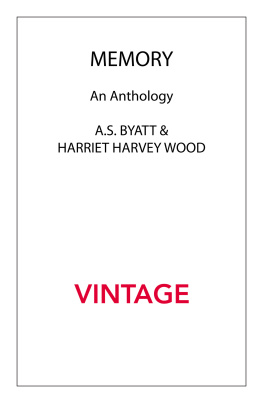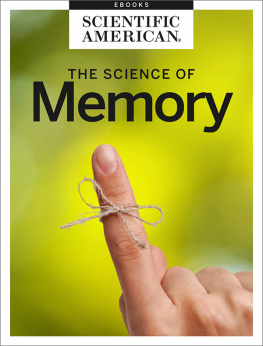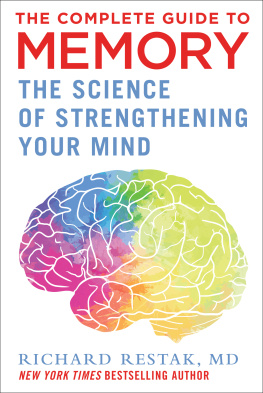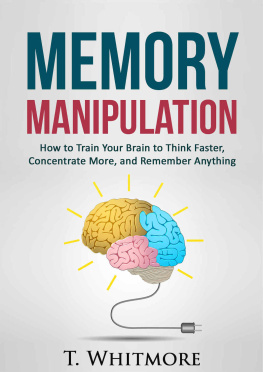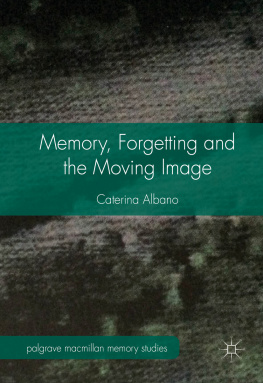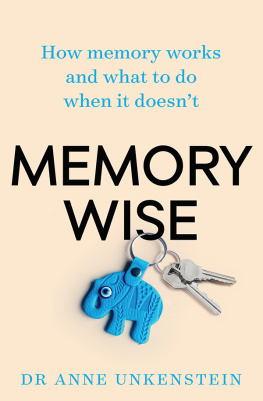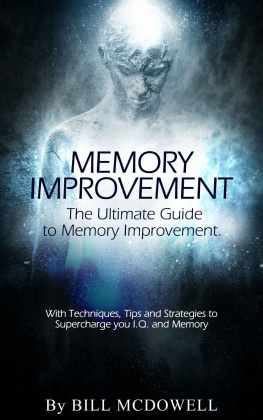Contents
A.S. BYATT &
HARRIET HARVEY WOOD
Memory
An Anthology

This ebook is copyright material and must not be copied, reproduced, transferred, distributed, leased, licensed or publicly performed or used in any way except as specifically permitted in writing by the publishers, as allowed under the terms and conditions under which it was purchased or as strictly permitted by applicable copyright law. Any unauthorized distribution or use of this text may be a direct infringement of the authors and publishers rights and those responsible may be liable in law accordingly.
Epub ISBN: 9781448162659
Version 1.0
1 3 5 7 9 10 8 6 4 2
VINTAGE
20 Vauxhall Bridge Road,
London SW1V 2SA
Vintage is part of the Penguin Random House group of companies whose addresses can be found at global.penguinrandomhouse.com.
Selection, introductions and edition copyright Harriet Harvey Wood and A.S. Byatt 2008
Harriet Harvey Wood and A.S. Byatt have asserted their rights under the Copyright, Designs and Patents Act 1988 to be identified as the authors of this work
Published by Vintage 2009
First published in Great Britain in 2008 by Chatto & Windus
penguin.co.uk/vintage
A CIP catalogue record for this book is available from the British Library
Contents
You have to begin to lose your memory, if only in bits and pieces, to realise that memory is what makes our lives.
Life without memory is no life at all Our memory is our coherence, our reason, our feeling, even our action.
Without it, we are nothing.
Luis Buuel, Memoirs
Its a poor sort of memory that only works backwards, the Queen remarked.
Lewis Carroll, Through the Looking-Glass, Chapter 5
Nessun maggior dolor
Che ricordarsi del tempo felice
Nella miseria.
Dante, Inferno
I remember
Those are pearls that were his eyes:
T.S. Eliot, The Waste Land
Introduction
A.S. Byatt
Memory is not quite the same thing as consciousness, but they are intricately, toughly and delicately intertwined. Someone once said that we consist of the pure, theoretical instant of awareness, and everything else is already memory. When we think of our selves we immediately begin to sort and arrange memories, which we then rearrange. We are fascinated by those who have through wounds or brain damage lost all or part of their memories. A terror of our time is living with dementia either in ourselves, or in those we share our lives with. Memories can be polished, like objects taken out, burnished, and contemplated, or they can flitter just out of reach, like lost threads of broken webs. To remember is to have two selves, one in the memory, one thinking about the memory, but the two are not precisely distinct, and separating them can be dizzying.
I have a memory I think of as The Memory. It is seen from the point of view of a small person just seeing over the wall of a playground in East Hardwick Elementary School. The stone is hot, and is that kind that flakes into gold slivers. The sun is very bright. There is a tree overhead, and the leaves catch the light and are golden, and in the shade they are blue-green. Over the wall, and across the road is a field full of daisies and buttercups and speedwell and shepherds-purse. On the horizon are trees with thick trunks and solid branches. The sky is very blue and the sun is huge. The child thinks: I am always going to remember this. Then she thinks: why this and not another thing? Then she thinks: what is remembering? This is the point where my self then and my self now confuse themselves into one. I know I have added to this Memory every time I have thought about it, or brought it out to look at it. It has acquired notes of Paradise Lost, which I dont think it had when I was five or six. It has got both further away and brighter, more and less real. I always associate it with one of my very few good memories of my maternal grandmother a perpetually cross person, who never smiled. The year she died, she began to forget, and forgot to be irritated. She said to me, sitting by the fire at Christmas, Do you remember all the beautiful young men in the fields? And she smiled at me like a sensuous young girl. She may have been talking about the airmen who were billeted on her in the war or she may have been remembering something from long before my mother was born. I shall never know. But I can see the young men in the fields.
Memory is an anthology of the ways people have thought about memory and, to a lesser extent, of things they have remembered. Harriet Harvey Wood and I have tried to cover as many fields philosophical, aesthetic, scientific, psychological, personal, social as we could, and this has inevitably meant that each section is inconclusive and suggestive, rather than offering anything like coverage. The anthology is in two parts. The first is a collection of substantial essays on memory, most of them specially commissioned, by scientists, artists, and thinkers from several fields. The second is a collection of extracts, arranged thematically. Harriet Harvey Woods Introduction to that section describes the principles of arrangement.
Craig Raine says in his essay in this book that Memory is like metaphor in its operations. He goes on Memory is sexual in its operations. (He is referring partly to the use of the word coming in describing sexual pleasure, which does certainly bear some relation to the pleasure of finding the desired memory from inside.) Memory is like metaphor and humans have always needed metaphors to think about memory. There is a long tradition, starting with Plato, which uses the metaphor of the mind as a soft wax surface, on which an image can be impressed, or as a gemstone, in which it can be engraved or scratched. St Augustine thought of his memory as palaces full of spaces in which he encountered thoughts and people. Memory can be a pit or well from which things rise to the surface. Lately I have once or twice, searching for names I know I know (and how do we know we know if we cant remember?) found myself looking down into an inky depth in which there was only absence, no elusive flickering fish. We invent machines to assist and fortify our memories, and then use these machines as metaphors for thinking about how memory works. Ulric Neisser, in a fine essay on deceptive certainties of remembering, points out that photographs record indifferently everything present to them, whereas no live memory works like that. He discusses the effects of using the images of recording machines and video cassettes, and of the flashbulb memory so bright and shocking that it is felt to be burned into the brain. We have computers which remember what we cannot, to which we bolt on added memory, or into which we insert memory sticks. We have the idea that we shall be able to insert a language, or a map, or mathematical skills, into our brains as we can into machines. But cognitive scientists like Neisser and Steven Rose, who work with the wet stuff, with the chemistry and biological organisation of the brain, have taught us to be wary of machine metaphors for bodily thought. Steven Roses essay in this anthology is both a lucid description of the history of the scientific study of memory, and a fascinating description of his own experimental work and that of others on understanding changes in the substance of brains as they make memories.

